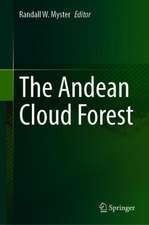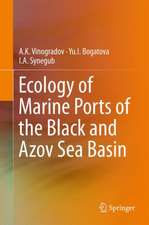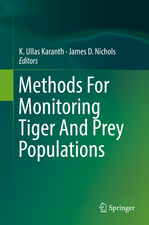Ecotones Between Forest and Grassland
Editat de Randall W. Mysteren Limba Engleză Paperback – 8 aug 2014
Ecotones Between Forest and Grassland explores how these ecotones have changed in the past, how they are changing today, and how they are likely to change in the future. The book includes chapters from around the world with a special focus on South American and Neotropical ecotones.
| Toate formatele și edițiile | Preț | Express |
|---|---|---|
| Paperback (1) | 946.72 lei 43-57 zile | |
| Springer – 8 aug 2014 | 946.72 lei 43-57 zile | |
| Hardback (1) | 955.25 lei 43-57 zile | |
| Springer – 11 iul 2012 | 955.25 lei 43-57 zile |
Preț: 946.72 lei
Preț vechi: 1154.54 lei
-18% Nou
Puncte Express: 1420
Preț estimativ în valută:
181.16€ • 189.62$ • 150.78£
181.16€ • 189.62$ • 150.78£
Carte tipărită la comandă
Livrare economică 31 martie-14 aprilie
Preluare comenzi: 021 569.72.76
Specificații
ISBN-13: 9781489995711
ISBN-10: 1489995714
Pagini: 344
Ilustrații: XIV, 330 p.
Dimensiuni: 155 x 235 x 18 mm
Greutate: 0.48 kg
Ediția:2012
Editura: Springer
Colecția Springer
Locul publicării:New York, NY, United States
ISBN-10: 1489995714
Pagini: 344
Ilustrații: XIV, 330 p.
Dimensiuni: 155 x 235 x 18 mm
Greutate: 0.48 kg
Ediția:2012
Editura: Springer
Colecția Springer
Locul publicării:New York, NY, United States
Public țintă
GraduateCuprins
1.Introduction.- Section I: Temperate forest-grassland ecotones: prairies, steppes, and pampas.- 2. Woodland-grassland ecotonal shifts in environmental mosaics: lessons learnt from the environmental history of the Carpathian Basin (Central Europe) during the Holocene and the last ice age based on investigation of paleobotanical and mollusk remains.- 3. Ecotones as complex arenas of disturbance, climate and human impacts: the trans-Andean forest-steppe ecotone of northern Patagonia.- 4. Woody-Herbaceous-Livestock Species Interaction.- 5. Woody plant invasions in Pampa grasslands ? a biogeographical and community assembly perspective.- Section II: Tropical forest-grassland ecotones: old fields, savannas, and llanos.- 6. Post-agricultural ecotones in Puerto Rico.- 7. South Brazilian forest-grassland ecotones: Dynamics affected by climate, disturbance and woody species traits.- 8.Long-term perspectives on Tropical forest-savanna dynamics in lowland Bolivia from the last ice age until the present.- 9.Using palaeoecological data to define main vegetation dynamics along the savanna-forest ecotone in Colombia: implications for accurate assessment of human impacts.- Section III: Boral and cloud forest-grassland ecotones: páramo and alpine grasslands.- 10. The dynamic history of the upper forest line ecotone in the northern Andes.- 11. Climatic drivers of tree growth and recent recruitment at the Pyrenean alpine tree line ecotone.- 12. The alpine treeline ecotone in the southernmost Swedish Scandes ? dynamism on different scales.-13.How climate and fire disturbances influence contrasted dynamics of Picea glauca ecotones at alpine tree lines in Atlantic and continental eastern North Ameria.-Conclusions, synthesis, and future directions.
Textul de pe ultima copertă
Ecotones are dynamic over-lapping boundary areas where major terrestrial
biomes meet. As past studies have shown, and as the chapters in this book will
illustrate, their structure, size, and scope have changed considerably over the
millennia, expanding and shrinking as climate and/or other driving conditions
have also changed. Today, however, many of them are changing at a rate not
seen for a long time, perhaps largely due to climate change and other humaninduced
factors. Indeed, ecotones are more sensitive to climate change than the
biomes on either side, and thus may serve as critical early indicators of future
climate change. As ecotones change, they also redefine the limits of the biomes
on either side by altering their distributions of species because, in addition to
their own endemic species, any ecotone will also have species from both
adjoining biomes. Consequently, they may also be places of high levels of
species interaction, serving as active evolutionary laboratories, which generate
new species that then migrate back into adjacent biomes.
Ecotones Between Forest and Grassland explores how these ecotones have
changed in the past, how they are changing today, and how they are likely to
change in the future. The book includes chapters from around the world with a
special focus on South American and Neotropical ecotones.
About the Editor
Randall W. Myster received his Ph.D from Rutgers University working with S. T. A.
Pickett on post-agriculture succession in New Jersey, USA. Dr. Myster’sfirst
academic position was at the University of Puerto Rico (UPR) where he conducted
tropical plant research in landslides and pastures, and also after banana, coffee
and sugarcane cultivation. He served as a CO-PI for 12 years on their LTER
grants. He left there for another position in Oklahoma where he conducted the
research in the Cross Timbers ecotone reported here. He continues to receive
support from UPR for work in Ecuador and Peru where he currently samples and
maintains a LTER set and also investigates flooded forests in the Western
Amazon. He teaches at Oklahoma State University-OKC.
Ecotones Between Forest and Grassland explores how these ecotones have
changed in the past, how they are changing today, and how they are likely to
change in the future. The book includes chapters from around the world with a
special focus on South American and Neotropical ecotones.
About the Editor
Randall W. Myster received his Ph.D from Rutgers University working with S. T. A.
Pickett on post-agriculture succession in New Jersey, USA. Dr. Myster’s first
academic position was at the University of Puerto Rico (UPR) where he conducted
tropical plant research in landslides and pastures, and also after banana, coffee
and sugarcane cultivation. He served as a CO-PI for 12 years on their LTER
grants. He left there for another position in Oklahoma where he conducted the
research in the Cross Timbers ecotone reported here. He continues to receive
support from UPR for work in Ecuador and Peru where he currentlysamples and
maintains a LTER set and also investigates flooded forests in the Western
Amazon. He teaches at Oklahoma State University-OKC.
About the Editor
Randall W. Myster received his Ph.D from Rutgers University working with S. T. A.
Pickett on post-agriculture succession in New Jersey, USA. Dr. Myster’s first
academic position was at the University of Puerto Rico (UPR) where he conducted
tropical plant research in landslides and pastures, and also after banana, coffee
and sugarcane cultivation. He served as a CO-PI for 12 years on their LTER
grants. He left there for another position in Oklahoma where he conducted the
research in the Cross Timbers ecotone reported here. He continues to receive
support from UPR for work in Ecuador and Peru where he currently samples and
maintains a LTER set and also investigates flooded forests in the Western
Amazon. He teaches at Oklahoma State University-OKC.
biomes meet. As past studies have shown, and as the chapters in this book will
illustrate, their structure, size, and scope have changed considerably over the
millennia, expanding and shrinking as climate and/or other driving conditions
have also changed. Today, however, many of them are changing at a rate not
seen for a long time, perhaps largely due to climate change and other humaninduced
factors. Indeed, ecotones are more sensitive to climate change than the
biomes on either side, and thus may serve as critical early indicators of future
climate change. As ecotones change, they also redefine the limits of the biomes
on either side by altering their distributions of species because, in addition to
their own endemic species, any ecotone will also have species from both
adjoining biomes. Consequently, they may also be places of high levels of
species interaction, serving as active evolutionary laboratories, which generate
new species that then migrate back into adjacent biomes.
Ecotones Between Forest and Grassland explores how these ecotones have
changed in the past, how they are changing today, and how they are likely to
change in the future. The book includes chapters from around the world with a
special focus on South American and Neotropical ecotones.
About the Editor
Randall W. Myster received his Ph.D from Rutgers University working with S. T. A.
Pickett on post-agriculture succession in New Jersey, USA. Dr. Myster’sfirst
academic position was at the University of Puerto Rico (UPR) where he conducted
tropical plant research in landslides and pastures, and also after banana, coffee
and sugarcane cultivation. He served as a CO-PI for 12 years on their LTER
grants. He left there for another position in Oklahoma where he conducted the
research in the Cross Timbers ecotone reported here. He continues to receive
support from UPR for work in Ecuador and Peru where he currently samples and
maintains a LTER set and also investigates flooded forests in the Western
Amazon. He teaches at Oklahoma State University-OKC.
Ecotones Between Forest and Grassland explores how these ecotones have
changed in the past, how they are changing today, and how they are likely to
change in the future. The book includes chapters from around the world with a
special focus on South American and Neotropical ecotones.
About the Editor
Randall W. Myster received his Ph.D from Rutgers University working with S. T. A.
Pickett on post-agriculture succession in New Jersey, USA. Dr. Myster’s first
academic position was at the University of Puerto Rico (UPR) where he conducted
tropical plant research in landslides and pastures, and also after banana, coffee
and sugarcane cultivation. He served as a CO-PI for 12 years on their LTER
grants. He left there for another position in Oklahoma where he conducted the
research in the Cross Timbers ecotone reported here. He continues to receive
support from UPR for work in Ecuador and Peru where he currentlysamples and
maintains a LTER set and also investigates flooded forests in the Western
Amazon. He teaches at Oklahoma State University-OKC.
About the Editor
Randall W. Myster received his Ph.D from Rutgers University working with S. T. A.
Pickett on post-agriculture succession in New Jersey, USA. Dr. Myster’s first
academic position was at the University of Puerto Rico (UPR) where he conducted
tropical plant research in landslides and pastures, and also after banana, coffee
and sugarcane cultivation. He served as a CO-PI for 12 years on their LTER
grants. He left there for another position in Oklahoma where he conducted the
research in the Cross Timbers ecotone reported here. He continues to receive
support from UPR for work in Ecuador and Peru where he currently samples and
maintains a LTER set and also investigates flooded forests in the Western
Amazon. He teaches at Oklahoma State University-OKC.
Caracteristici
Includes chapters from around the world with a special focus on South American and Neotropical ecotones While the book has chapters from around the world, there is a special focus on South American and Neotropical ecotones Puts post-agricultural areas in a wider context by presenting them as a kind of ecotone



























